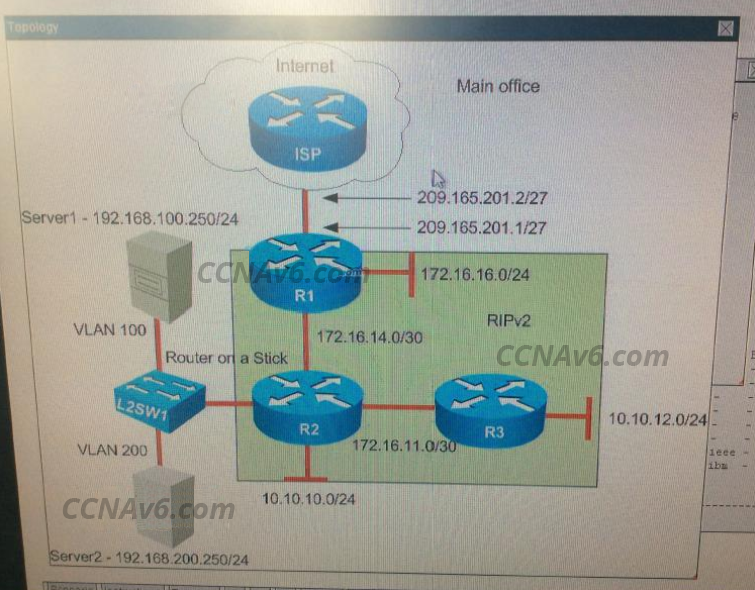
– Router R1 connects the Main office to internet, and routers R2 and R3 are internal
routers
– NAT is enabled on Router R1
– The routing protocol that is enabled between Rl, R2 and R3 is RIPv2
– R1 sends default route into RIPv2 for internal routers to forward internet traffic to R1
– Serverl and Server 2 are placed in VLAN 100 and 200 respectively, and are still running on stick
– Configuration with router R2.
– You have console access on Rl, R2, R3 and L2SW1 devices.
– Use only show commands to troubleshoot the issues
Download RIPv2 Troubleshooting Sim Packet Tracer file .PKA
1. Refer to the topology below and answer the questions using “show” commands.
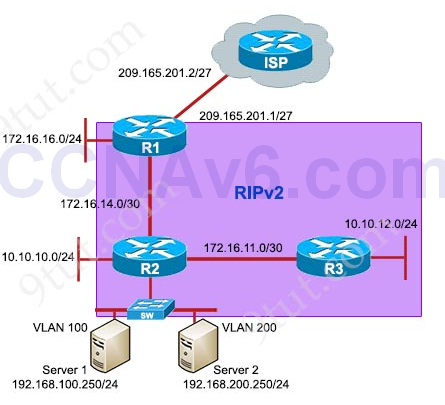
Server1 and Server2 are unable to communicate with the rest of the network. Your initial check with system administrators shows that IP address settings are correctly configured on the server side. What could be an issue?
- The VLAN encapsulation is misconfigured on the router subinterfaces.*
- The Router is missing subinterface configuration.
- The Trunk is not configured on the L2SW1 switch.
- The IP address is misconfigured on the primary router interface.
Explanation/Reference:
Check the configuration of the interface that is connected to Server1 and Server2 on R2 with show running-config command.
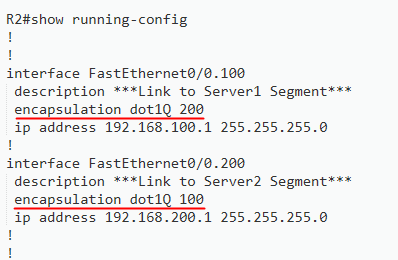
We see that subinterface FastEthernet0/0.100 has been configured with VLAN 200 (via encapsulation dot1Q 200 command) while Server1 belongs to VLAN 100. Therefore this configuration is not correct. It should be encapsulation dot1Q 100 instead. The same thing for interface FastEthernet0/0.200, it should be encapsulation dot1Q 200 instead.
2. Refer to the topology below and answer the questions using show commands.

Users in the main office complain that they are unable to reach internet sites. You observe that internet traffic that is destined towards ISP router is not forwarded correctly on Router R1. What could be an issue?
Ping to Internet server shows the following results from R1:
R1#ping 209.165.200.225
Type escape sequence to abort.
Sending 5, 100-byte ICMP Echos to 209.165.200.225, timeout is 2 seconds:
…..
Success rate is 0 percent (0/5)
- The next hop router address for the default route is incorrectly configured.
- Default route pointing to ISP router is not configured on Router R1.*
- Default route pointing to ISP router is configured with AD of 225.
- Router R1 configured as DHCP client is not receiving default route via DHCP from ISP router.
Explanation/Reference:
When all the users cannot reach internet sites we should check on the router connecting to the ISP to see if it has a default route pointing to the ISP or not. Use the show ip route command on R1:
R1#show ip route
Codes: C - connected, S - static, I - IGRP, R - RIP, M - mobile, B - BGP
D - EIGRP, EX - EIGRP external, O - OSPF, IA - OSPF inter area
N1 - OSPF NSSA external type 1, N2 - OSPF NSSA external type 2
E1 - OSPF external type 1, E2 - OSPF external type 2, E - EGP
i - IS-IS, L1 - IS-IS level-1, L2 - IS-IS level-2, ia - IS-IS inter area
* - candidate default, U - per-user static route, o - ODR
P - periodic downloaded static route
Gateway of last resort is not set
10.0.0.0/24 is subnetted, 1 subnets
R 10.10.10.0 [120/1] via 172.16.14.2, 00:00:00, FastEthernet1/0
172.16.0.0/16 is variably subnetted, 3 subnets, 2 masks
R 172.16.11.0/30 [120/1] via 172.16.14.2, 00:00:00, FastEthernet1/0
C 172.16.14.0/30 is directly connected, FastEthernet1/0
C 172.16.16.0/24 is directly connected, Loopback0
R 192.168.1.0/24 [120/1] via 172.16.14.2, 00:00:00, FastEthernet1/0
R 192.168.100.0/24 [120/1] via 172.16.14.2, 00:00:00, FastEthernet1/0
R 192.168.200.0/24 [120/1] via 172.16.14.2, 00:00:00, FastEthernet1/0
209.165.201.0/27 is subnetted, 1 subnets
C 209.165.201.0 is directly connected, FastEthernet0/0
R1#
We cannot find a default route on R1 (something like this: S* 0.0.0.0/0 [1/0] via 209.165.201.2) so maybe R1 was not configured with a default route. We can check with the show running-config on R1:

We need a default route (like ip route 0.0.0.0 0.0.0.0 209.165.201.2) but we cannot find here so we can conclude R1 was not be configured with a default route pointing to the ISP router.
3. Refer to the topology below and answer the questions using show commands.
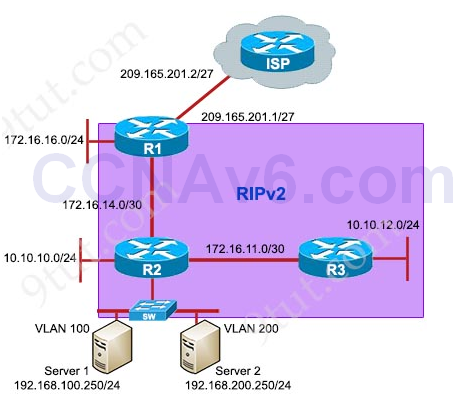
Examine R2 configuration, the traffic that is destined to R3 LAN network sourced from Router R2 is forwarded to R1 instead R3. What could be an issue?
R2#traceroute 10.10.12.1 source 10.10.10.1
Type escape sequence to abort.
Tracing the route to 10.10.12.1
VRF info: (vrf in name/id, vrf out name/id)
1 172.16.14.1 0 msec 1 msec 0 msec
2 172.16.14.1 !H !H *
R2#
- RIPv2 enabled on R3, but R3 LAN network that is not advertised into RIPv2 domain.
- RIPv2 routing updates are suppressed between R2 and R3 using passive interface feature.
- RIPv2 not enabled on R3.*
- No issue that is identified; this behavior is normal since default route propagated into RIPv2 domain by Router R1.
Explanation/Reference:
First we should check the routing table of R2 with the show ip route command

In this table we cannot find the subnet 10.10.12.0/24 (R3 LAN network) so R2 will use the default route advertised from R1 (with the command default-information originate on R1) to reach unknown destination, in this case subnet 10.10.12.0/24 -> R2 will send traffic to 10.10.12.0/24 to R1.
Next we need to find out why R3 did not advertise this subnet to R2. A quick check with the “show running-config” on R3 we will see that R3 was not configured with RIP ( no “router rip” section). Therefore we can conclude RIPv2 was not enabled on R3.
4. Refer to the topology below and answer the questions using “show” commands.

What is the correct statement below after examining the R1 routing table?
- Traffic that is destined to 10.10.10.0/24 from R1 LAN network uses static route instead RIPv2 because the static route AD that is configured is less than the AD of RIPv2
- Traffic that is destined to 10.10.10.0/24 from R1 LAN network uses RIPv2 instead of static route because the static route AD that is configured is higher than the AD of RIPv2*
- Traffic that is destined to 10.10.10.0/24 from R1 LAN network uses static route instead of RIPv2 but the traffic is forwarded to the ISP instead of the internal network
- Traffic that is destined to 10.10.10.0/24 from R1 LAN network uses RIPv2 instead of static route because the static route AD that is configured is 255
Explanation/Reference:
Surely we have to use the show ip route command to check the R1 routing table.
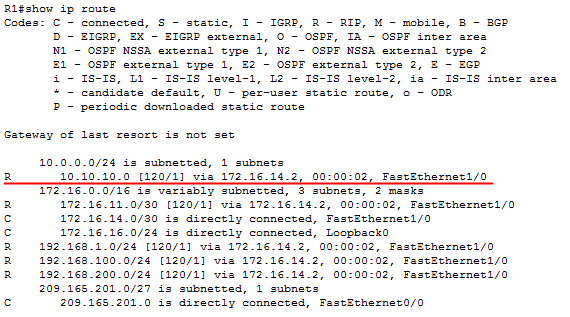
As we see here, 10.10.10/24 is learned from RIP. Notice that although there is a static route on R1 to this destination (you can check with the show running-config on R1 to see the line ip route 10.10.10.0 255.255.255.0 172.16.14.2 200), this static route is not installed to the routing table because it is not the best path because the Administrative Distance (AD) of this static route is 200 while the AD of RIP is 120 -> R1 chose the path with lowest AD so it chose path advertised via RIP.










very informative! thank you!